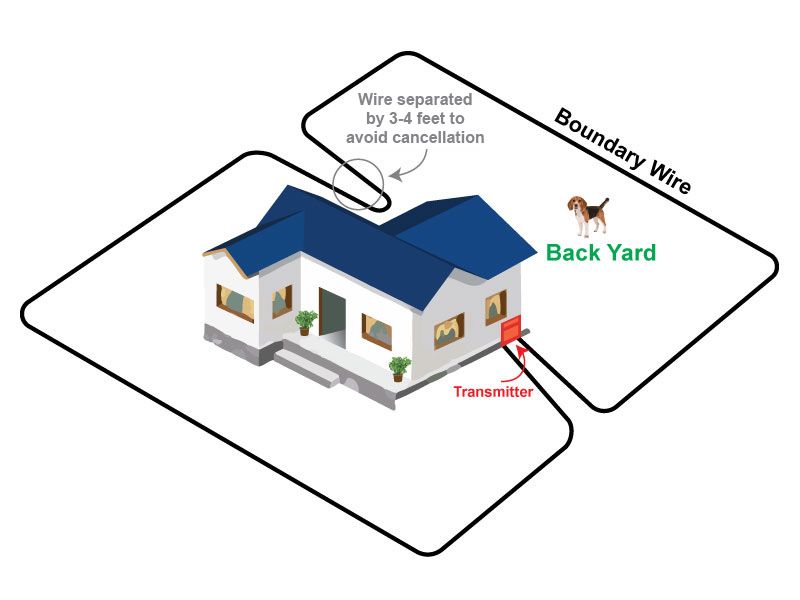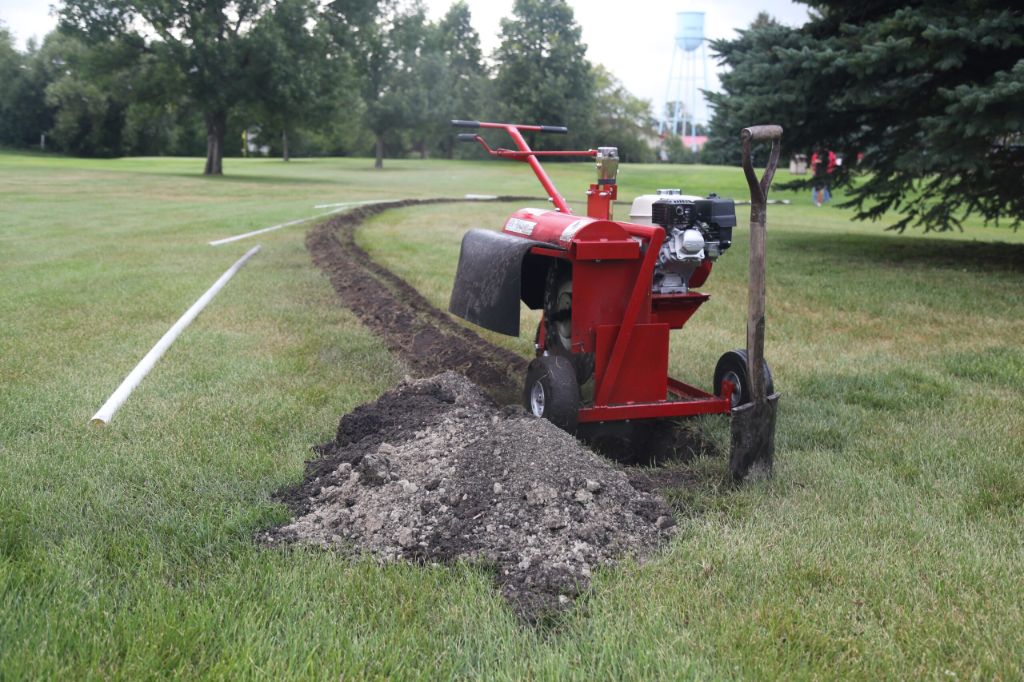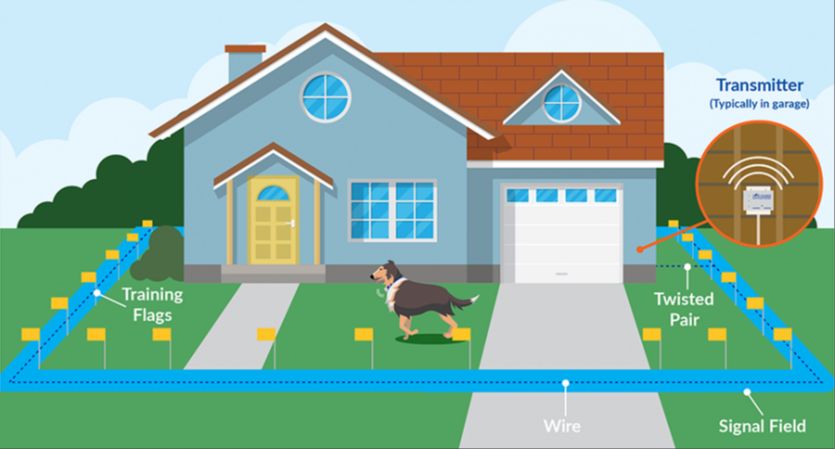What is an Electric Dog Fence?
An electric dog fence is a containment system that uses a wire buried underground or attached to a fixed boundary to define the perimeter of an area, such as a yard. The wire carries a mild electric current which triggers a warning beep or static shock from a receiver collar worn by the dog when it approaches the boundary (1). This trains the dog to stay within the set confines.
There are two main types of electric dog fences: underground and above ground. Underground systems involve burying a wire around the perimeter, about 3-6 inches below the ground. Above ground systems use a wire attached to a fixed boundary like a wall or fence (2). Both work on the same principle of using a mild static correction to deter dogs from crossing the boundary.
Electric dog fences are a form of humane containment that prevents dogs from roaming or escaping, without using physical barriers. They can be customized to any shape and give dogs more freedom in a defined space. When properly installed and trained, electric dog fences are over 90% effective at containing dogs (3).
(1) https://www.dogproofer.com/blogs/resources/how-much-does-a-wireless-invisible-fence-cost
(2) https://blog.tryfi.com/electric-fence-for-dogs/
(3) https://www.dogguardofthelowcountry.com/how-it-works/overview
Above-Ground vs. Underground Electric Dog Fences
Electric dog fences come in two main types – above-ground fences and underground fences. Both have their pros and cons that should be considered when deciding which is best for your situation.

Underground electric fences, also known as in-ground or buried fences, have wires that are buried just under the ground along the perimeter of the containment area. According to Fetcher’s FM, underground fences provide more reliability and consistency than above-ground systems since the signals are not impacted by environmental factors like rain or snow https://fetchersfm.com/in-ground-or-above-ground-fence/. However, they require more extensive installation by burying the wires. Underground systems also work better for larger yards and uneven terrain.
Above-ground electric fences use wires attached to posts or existing fences. As noted by VCA Hospitals, above-ground fences are quick and easy to install without trenching or burying wire https://vcahospitals.com/know-your-pet/the-pros-and-cons-of-invisible-fences-for-dogs. They can also be moved or expanded more easily than underground systems. However, above-ground fences may be impacted by environmental conditions and the visibility of the wires may not be as aesthetically pleasing for some homeowners.
Overall, underground electric fences provide maximum security but require more work to install, while above-ground systems are quick and adjustable but not as robust. Assessing your specific needs and environment will help determine whether an underground or above-ground electric dog fence is preferable.
Installation of Underground Electric Dog Fences
Installing an underground electric dog fence requires careful planning and execution. Here are the key steps:

Step 1: Mark the Boundary
First, use spray paint or stakes and string to clearly mark the boundary for the buried wire. Consider how much space your dog needs and obstacles to avoid. Map out a continuous loop for best results.
Step 2: Dig the Trench
Dig a trench about 3-5 inches deep around the marked boundary. The trench should be 1-3 inches wide. Use a shovel, garden trowel or trenching tool. Go around any existing fences, trees and structures.
Step 3: Install the Wire
Place the boundary wire at the bottom of the trench and secure with landscape staples. Ensure there are no sharp bends or kinks in the wire. Leave access where the wire will connect to the transmitter.
Step 4: Connect and Test
Connect the boundary wire to the transmitter following the product instructions. Turn on the system and test that the wire is active along the entire loop using the included collar tester.
Step 5: Fill and Restore the Trench
Fill in the trench carefully with dirt, avoiding any damage to the wire. Replace any turf or plants disturbed in the digging process to blend the trench back into the landscape.
Installing the underground wire properly is crucial for an invisible boundary. Follow the steps closely and refer to the product manual as needed throughout the process.
Tips for Installing Underground Electric Dog Fences
When installing an underground electric dog fence, it’s important to follow some best practices to ensure proper functionality and containment of your pet. Here are some top tips for installing underground dog fences:
Plan the boundary layout ahead of time and use flags or spray paint to mark the boundary lines. Make sure to lay the wire in a consistent pattern and leave no gaps in coverage. To go around obstructions like trees or gardens, curve smoothly rather than making sharp turns.
Bury the wire 1-3 inches underground consistently throughout the yard, taking care around sprinklers or irrigation systems. Go under any driveways or sidewalks by boring horizontally using a specialized tool. Use a wire splicing kit for any wire splices needed.
Use caulk or waterproof tape to seal any holes where the wire enters the house for the control box. Leave some slack in the wire at these access points for future maintenance. Attach the wire to the control box following the manufacturer’s instructions.
Test the system thoroughly once installed by walking the boundary with the collar held at your pet’s neck height. Make any adjustments needed until the system reliably contains your pet. Refer to the manufacturer’s installation guide for more specifics.
Considerations for Above-Ground Electric Dog Fences
Above-ground electric dog fences do not require burying wire underground like in-ground systems. This makes installation quicker and easier, but there are some factors to consider with above-ground fences:

Durability – Above-ground wires are more exposed and may be chewed by dogs or damaged by lawn equipment. In-ground systems tend to be more durable. Check wire thickness and coating when comparing products (source).
Aesthetics – Exposed wires may be considered unsightly. Some systems have “invisible” thin wires to improve appearance. Consider fence placement and landscaping to help it blend into the yard.
Maintenance – Above-ground fences need to be frequently checked for damage and may require repairs or full replacement over time. In-ground systems are more “set and forget.”
Boundary Issues – Exposed wires can sag or shift over time and may need adjustment to maintain correct boundary shape. In-ground wires keep shape better when buried.
Safety – Take care to keep exposed wires out of high traffic areas. Mark boundaries clearly. Monitor children or guests in the yard.
Testing Layout – It’s easy to temporarily lay out above-ground wires to test fence coverage and find the optimal layout before permanently mounting the wires.
By considering these factors, you can determine if an above-ground electric fence is the right choice for containing your dog.
Maintenance Requirements
Proper maintenance is crucial for any electric dog fence to operate effectively long-term. Both underground and above-ground systems require regular upkeep and monitoring.
For underground fences, it’s important to routinely check that the wires are still buried and haven’t become unearthed over time. The transmitter and receiver collars also need batteries replaced about once a month. Per Pet Control HQ, the boundary width should be tested monthly to ensure correct functionality. Any damage to the wire will need to be located and repaired.
Above-ground fences require checking that the transmitters are aligned and operational. Batteries in the collars need regular replacement as well. It’s also important to make sure the transmitters haven’t been knocked out of position over time. Periodic testing of the boundary width is recommended. Overall, above-ground fences tend to need more frequent maintenance than underground systems.
No matter the type, annual maintenance checks by a professional can identify any issues early before they become major problems. With proper, ongoing maintenance, an electric dog fence can remain effective for many years.
Cost Comparison
The cost of an electric dog fence can vary significantly depending on whether you choose an underground or above-ground system. Underground electric fences tend to be more expensive due to the labor and materials involved in burying the wire. According to Angi, underground systems range from $1000 to $1650 depending on the length of fence required and number of collars needed (1).
Above-ground systems do not require burial and are simpler to install yourself, so they tend to be more affordable. Pricing can range from $200 for a basic kit meant for small areas up to $1000 or more for a system to cover 1+ acres. You’ll also need to factor in the cost of boundary flags and signage.
Overall, above-ground systems provide the most budget-friendly option for containing your dog. However, some homeowners prefer the aesthetics and security of an underground system despite the higher upfront investment. Consider both your budget and containment needs when deciding which type works best for your situation.
(1) https://www.angi.com/articles/how-much-invisible-fence-cost.htm
Effectiveness for Containing Dogs
Underground electric dog fences can be very effective for containing dogs within a boundary. According to https://vcahospitals.com/know-your-pet/the-pros-and-cons-of-invisible-fences-for-dogs, invisible or underground fences adapt well to any terrain and layout, allowing you to create boundaries matching your property lines. The electric stimulus delivered through the dog’s collar when crossing the underground boundary is a strong deterrent for most dogs to avoid leaving the yard. However, high prey drive dogs may still be motivated to run through the boundary if sufficiently motivated.
Above-ground electric fences can also contain dogs, but may be less effective for determined escape artists. According to https://fetchersfm.com/in-ground-or-above-ground-fence/, above-ground fences work best for respectful dogs less prone to digging under or jumping over physical barriers. The electric stimulus can deter crossing the fence line, but highly motivated dogs may still find ways around. Proper training is essential for above-ground systems.
Aesthetic Differences
One of the most notable differences between underground and above-ground electric dog fences is appearance. Underground systems are completely invisible, with the wire buried a few inches below the surface along the perimeter you want to contain your dog. This allows the fence line to blend into the landscape for a clean, unobstructed look. Above-ground systems rely on boundary flags or barriers that are highly visible to both humans and dogs.

Underground dog fences are often preferred for their discreet aesthetics. Property owners don’t have to look at fence wires, posts, or other equipment since it’s all buried underground. The only visible components are small transmitter boxes attached to the outside of the house and collar receivers on dogs. With no visible boundaries, curbs or landscape edges can act as virtual barriers. Yards have an open, expansive appearance without fences interrupting sightlines (Source).
In contrast, above-ground systems rely on visible markers to define the containment zone. Boundary flags, wires, or barricades are placed around the perimeter, clearly delineating the space. While functional for pets, these visible barriers can be considered unsightly. They disrupt landscape views and make properties appear smaller or closed in. However, above-ground systems may suit homeowners who want their fence line clearly marked for themselves or guests.
When choosing between underground and above-ground electric dog fences, homeowners should consider how the aesthetics align with their landscape design and preferences. Underground systems provide an invisible containment solution that preserves open sightlines, while above-ground fences clearly mark boundaries but can be visually disruptive.
Is Buried Electric Fencing Necessary?
Burial of electric dog fence wiring is not an absolute requirement for effective containment and training. While burying the wire can provide some advantages like improved aesthetics and protection from damage, above-ground systems using boundary flags or wire stands can also be effective.
The key factors in containment success are proper installation to establish a consistent boundary, adequate training so dogs understand the cues, and maintaining the system. As long as these are achieved, underground wiring is not essential.
For most situations, above-ground fences are the most affordable and convenient option. They allow flexibility in layout and are easier to troubleshoot. However, for some homeowners aesthetics or local regulations may dictate buried wiring. In either case, with proper use electric dog fences can safely and humanely contain pets.
When making a decision, owners should consider upfront costs, installation requirements, aesthetic preferences, and the temperament of their pet. Adding boundary training reinforcement like signs and flags is also recommended regardless of system type. With training, both buried and above-ground electric dog fences can be effective alternatives to traditional fencing.